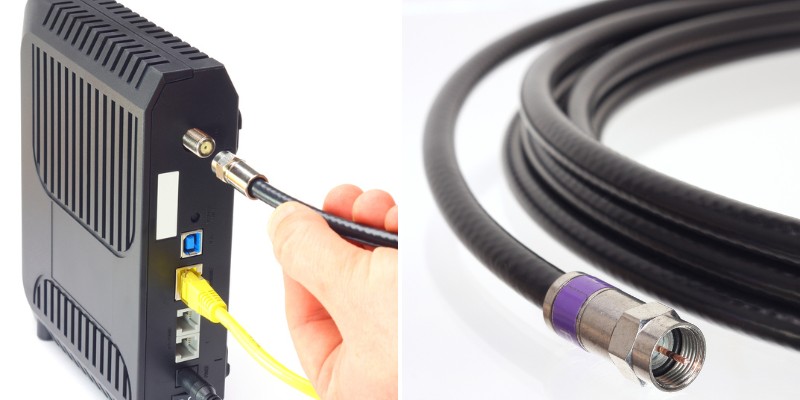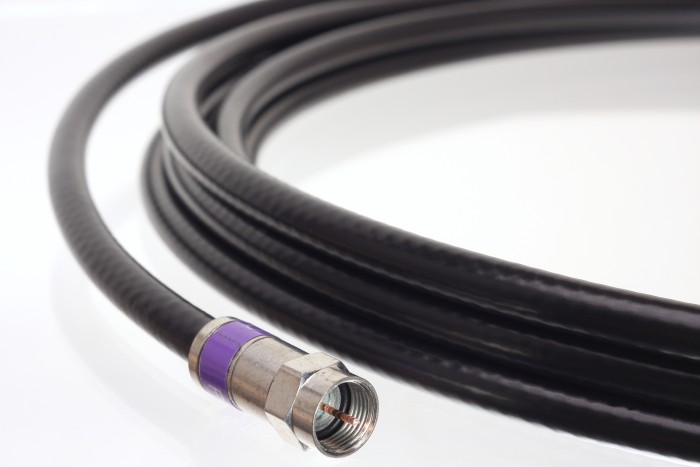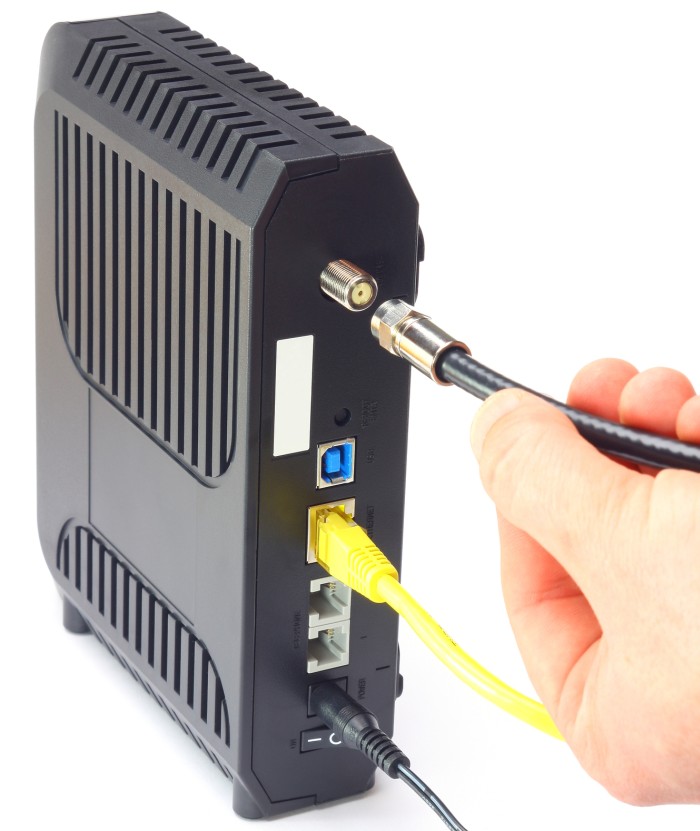These days, having reliable internet service isn’t a luxury—it’s a necessity. That means understanding the various modes of internet service delivery is quite important.

In the US, there are three main types of broadband internet service in use today. They are DSL, fiber-optic, and cable internet service.
Of the three, cable internet is one of the most common and widely used. That’s because it comes with some significant benefits that other types of service don’t necessarily offer.
It’s not perfect, though. To elaborate, here are the main pros and cons associated with cable internet service.
The Pros of Cable Internet Service
Cable internet service refers to internet delivered via coax cable, like cable television.
In fact, the vast majority of cable internet providers also operate large, legacy cable television businesses, as well. Here are the most important advantages associated with cable internet:
High Maximum Internet Speeds
For a while, fiber-to-the-home (FTTH) internet service was the undisputed speed champion of all internet services. That’s because it featured a theoretical maximum download speed of 10 Gbps. However, most real-world fiber internet services peaked at 1 Gbps.
Cable internet has made significant speed gains of late, owing to the continual improvement of the Data Over Cable Services Interface Specification (DOCSIS) protocol.
That’s the communication standard that allows for high-speed data transfer over coaxial cable.
Today, most cable operators rely on the DOCSIS 3.0 standard, which allows theoretical maximum download speeds of up to 1 Gbps and practical download internet speeds of around 300-500 Mbps.
It’s important to note, however, that DOCSIS 3.0 is already on its way out. Its immediate successor, DOCSIS 3.1, can deliver up to 10 Gbps of download throughput in theory, and 1Gbps of actual Internet download speed which is the same as fiber optic service.
And the upcoming DOCSIS 4.0 standard promises 10 Gbps download speeds and upload speeds up to 6 Gbps, bringing cable internet ever closer to true symmetrical speeds.
DOCSIS Is a Mature Cable Internet Technology
It’s also worth noting that the maturity of the DOCSIS standard is also a major advantage enjoyed by cable internet.
It’s an international standard used by virtually every cable internet provider in the world. As such, it’s considered mature and reliable, and there’s plenty of expertise to go around to keep DOCSIS-based services running.
DOCSIS, as noted previously, is also under active development. Its first official version appeared in 1997, and it continues to undergo significant periodic upgrades.
That means any flaws or deficiencies in the technology don’t last long. It also means that DOCSIS isn’t likely to be phased out anytime soon, unlike other legacy internet technologies like DSL.
One Cable, Multiple Services
Another major advantage of cable internet is the fact that it relies on existing coaxial cable infrastructure.

That’s the same cable that’s delivered an ever-expanding array of services to homes and businesses since the late 1940s.
Initially, coax cable served to give rural homes access to broadcast television signals via shared community antennas placed in elevated positions.
In the years since, however, cable operators went digital, offering hundreds of television channels, phone service, home security options, and myriad other value-added services.
Since its introduction around 1997, cable internet has turned into the most popular and accessible type of broadband available.
That popularity is owed to the fact that consumers could receive multiple services via a single, already-installed cable connection.
Service Bundling Yields Savings
Being able to access multiple services via a single cable connection isn’t only convenient, but it’s often economical for consumers, too.
Cable operators leverage their panoply of services to offer consumers bundle deals that lower the cost of each individual service.
Also, consumers can often select from the provider’s list of services to pay only for what they need. It’s an efficient mode of multi-service delivery that most other kinds of internet providers can’t or don’t offer.
Cable Internet Is Reliable
Another advantage that comes with cable internet is reliability. Since it’s based on well-understood technology and well-maintained infrastructure, service outages are typically rare.
When they do occur, cable companies are adept at pinpointing and fixing problems fast.
Also, since much of the cable infrastructure the services rely on is underground, cable internet isn’t as vulnerable to storms and other weather events, unlike services such as DSL.
In fact, a loss of power is more likely to cause an outage to a cable internet service than a problem with the service itself—which some providers mitigate by offering battery backup solutions for their modems.
Large Service Coverage Area
Cable internet is also among the most widely-available types of internet service in the US.
According to independent analysis, around 88% of households have at least one cable internet provider option. According to the cable industry itself, the number is 90%.
Either way, it’s a footprint that dwarfs all other internet service types in the US. That’s especially true since many of the major DSL operators—including AT&T—are aggressively decommissioning the copper phone lines required for that service.
The Cons of Cable Internet Service
Of course, cable internet also has its share of cons associated with it. Although most aren’t deal breakers, they’re worth knowing about as you evaluate your internet service options. Here’s what they are.
Cable Internet Is Asymmetric
One big downside associated with cable internet is the fact that it offers asymmetric speeds.
That means download speeds and upload speeds aren’t the same. In most cases, download speeds are far faster than upload speeds.
This is because current-generation DOCSIS modems are half-duplex and also the download and upload cable channels used in the protocol are different.
This means they can only transmit or receive data at any given time but can’t do both simultaneously. Also the download speed is faster than upload speed because the download channels are more than the upload channels (e.g 8×4, 16×4 modems etc).
In practice, this is rarely an issue since most modern internet applications rely on fast download speeds.
However, for certain business uses and next-generation real-time communications technology, it could turn into a problem.
Fortunately, the previously-discussed DOCSIS 4.0 standard should solve the problem, but it’s unknown when it will enter real-world use.
Shared Bandwidth Makes Bottlenecks an Issue
If you observe most advertisements for cable internet services, you’ll notice that they never offer guaranteed speeds. They’re quite careful to add the phrase “up to” before any listed speed indication.
This is because cable internet relies on shared bandwidth that’s divided amongst individual users. In most situations, residents of a single area or neighborhood will all connect via a single node that connects to the provider’s backbone network.
That means if you’re unlucky enough to be in a neighborhood with lots of cable internet customers, your service speeds may never reach the advertised rates.
Also, if you happen to be anywhere near a high-density commercial area, you could have the same problem.
In practice, most cable providers try to fix the problem by adding additional nodes when necessary—but are notoriously slow in doing so since it costs them significant sums.
A Limited Number of Providers
Unfortunately, the rapid growth of the cable television industry in the US came at a cost for consumers.
That cost was that many providers operate as legal monopolies in the areas they service.
Essentially, local governments granted them that right as an enticement to spend the huge amounts of money necessary to install cable infrastructure in the first place.
Today, that legacy means that 49.7 million Americans only have a single choice when it comes to cable internet providers.
And, those that have more than one choice often fare no better, since their supposed options consist of slower or inferior services like DSL.
The lack of competition translates into higher service prices, which helps to explain why most Americans pay far more for internet service than comparable populations in wealthy and developed areas like Europe.
Modem Rental Fees Increase Costs
The final notable con associated with cable internet service is that most providers charge significant fees to rent the modems required to use their service.

Theoretically, consumers can purchase their own modems to avoid the fees, but there are a few impediments to them doing so.
The first is that the cable internet providers don’t exactly make it public knowledge that buying your own modem is possible. Then, they’ll often refuse to troubleshoot any connection issues you run into with your own modem.
On top of that, consumers have no control over when a cable internet provider decides to upgrade their network.
When that happens, such as when a provider moves to a newer DOCSIS version, older consumer-owned hardware becomes obsolete.
That means most cable internet users choose to rent their modems and pay whatever fee the provider charges, even when those charges aren’t exactly fair and transparent.
The Bottom Line
At the end of the day, cable internet offers one of the best and most versatile internet service options on the market today.
It offers consumers high speeds, reliability, and a coverage area that no other service type can match.
However, its asymmetric nature (right now), potential for network congestion, and lack of competition do represent significant drawbacks for consumers.
Now that you know all of that, though, you can choose between internet service options with confidence that you’ll select the one that best fits your needs.
Leave a Reply